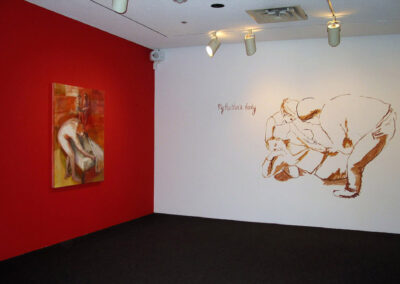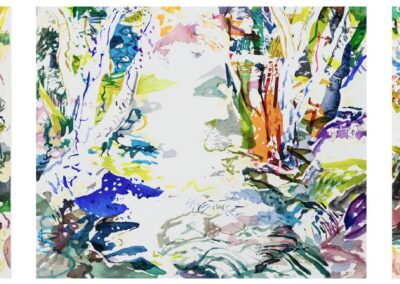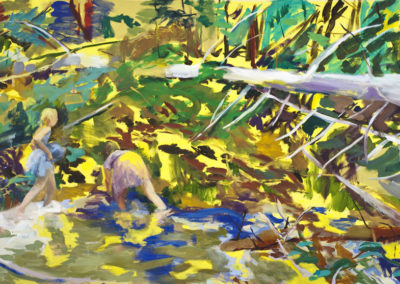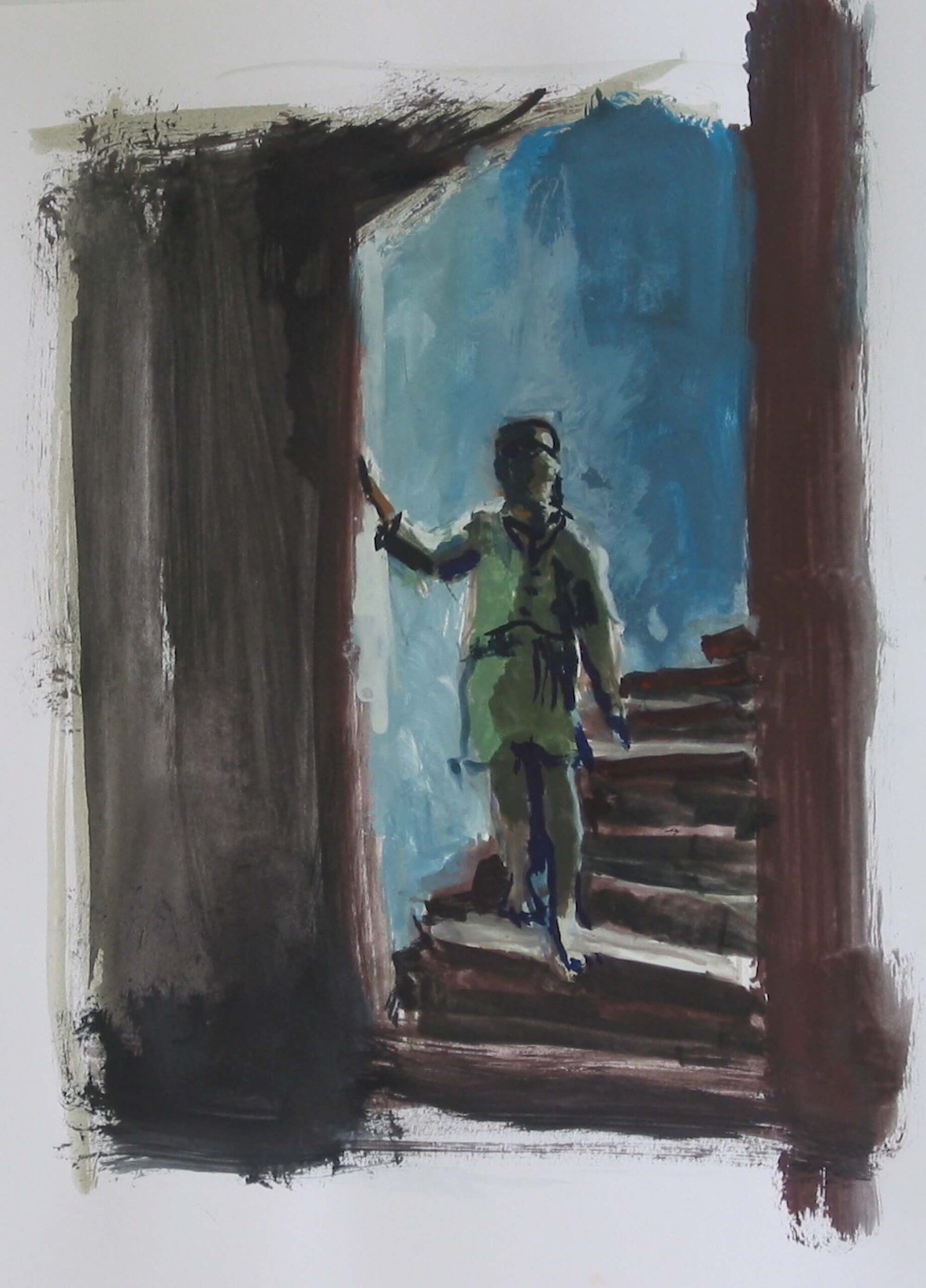Hidden Children Project – In Progress
CALQ VERSION – IMAGES
IMAGE LIST – CALQ
1 Installation – “Blindman’s Buff” Galerie Nikki Diana Marquardt, PARIS, France, 1988
2 Installation “Les enfants terribles” – Dalhousie University Gallery, Halifax, Nova Scotia 2004
3 Installation “Les enfants terribles” – Maison de Culture – Pointe aux Trembles 2005
4 Installation “Oasis” Galerie Eric Devlin, Montreal, Quebec 2011
5 Installation Variations, BADA – Beaux-arts des Amériques, Montreal, Quebec, 2017
6 a page from Life? or Theater? (Leben? oder Theater?) by Charlotte Solomon – Charlotte’s conflict with her drawing teacher | © Charlotte Salomon Foundation, Amsterdam.
This image is one of Salomon’s 749 drawings dramatizing her autobiography, the greatest inspirations behind my series “Hidden Children”, as well as many of my other narrative series. Salomon created them while hiding from the Nazis only to be captured and killed in Auschwitz in 1943
7 Young Artist #10 – Yellow Band, (Young artists series) ink and acrylic on paper, 30 x 22 / 76.2 x 55.88 cm
I wondered what it would have been like to be an Jewish art student under the Reich, and forced to wear the yellow arm band with the Jewish star….
8 Water Slips Past, 50 x 144” / 127 x 365.76 cm , oil on canvas, 2020
9 Night Incomplete 2011, 147 x 193 cm 58 x 76 inches oil on canvas catalogue # 11d01
Even in my landscape series, children are often hidden within the texture of the landscapes.
10 Fallen, 2011, 68 x 120 in / 173 x 305 cm, oil on canvas
11 78a292 (Windows Series) The Party, 31 x 35 in / 78.74 x 88.9 cm, gouache & pastel on cut out paper
collection McLaughlin Gallery Oshua
The works of my early collage series “Windows” dealt with what is hidden behind the doors and windows of our homes.
12 Hide and Seek,1988, 84 x 64 inches / 213.36 x 162.56 cm, oil on canvas
13 88D46 The Fighters, 60 x 70 /152.4 x 177.8 , oil on canvas, Blindman’s Buff series
14 Hidden Children study, 2010, gouache on paper, 11 x 14 inches / 27.94 x 35.56 cm
15 Hidden Children study, 2010, gouache on paper, 11 x 14 inches / 27.94 x 35.56 cm
CC VERSION – IMAGES
IMAGE LIST – CANADA COUNCIL
1 Installation – “Blindman’s Buff” Galerie Nikki Diana Marquardt, PARIS, France, 1988
2 Installation – “Blindman’s Buff” Galerie Michel Tetrault Montreal, Quebec, 1990
3 Installation “Les enfants terribles” – Dalhousie University Gallery, Halifax, Nova Scotia 2004
4 Installation “Les enfants terribles” – Maison de Culture – Pointe aux Trembles 2005
5 Installation “Oasis” Galerie Eric Devlin, Montreal, Quebec 2011
6 Installation Variations, BADA – Beaux-arts des Amériques, Montreal, Quebec, 2017
7 page from Life? or Theater? (Leben? oder Theater?) by Charlotte Salomon images – Collection Jewish Historical Museum, Amsterdam, © Charlotte Salomon Foundation, Charlotte Salomon®, www.jck.nl, www.jhm.nl/collections/specials/charlotte-salomon
This image is one of the greatest inspirations behind my series “Hidden Children”, as well as many of my other narrative series. Salomon created her collection of drawings, part of a dramatized biography, while hiding from the Nazis only to be captured and killed in Auschwitz in 1943
8 Charlotte Solomon images – Charlotte’s conflict with her drawing teacher | © Charlotte Salomon Foundation, Amsterdam.
9 Young Artist #10 – Yellow Band, (Young artists series) ink and acrylic on paper, 30 x 22 / 76.2 x 55.88 cm
I wondered what it would have been like to be an Jewish art student under the Reich, and forced to wear the yellow arm band with the Jewish star….
landscapes
10 The World is Round oil on canvas, 2017 152.4 x 365.76 cm / 60″ x 144″
11 Water Slips Past, 50 x 144” / 127 x 365.76 cm , oil on canvas, 2020
12 78a292 (Windows Series) The Party, 31 x 35 in / 78.74 x 88.9 cm, gouache & pastel on cut out paper
collection McLaughlin Gallery Oshua
The works of my early collage series “Windows” dealt with what is hidden behind the doors and windows of our homes.
13 78a276 (Windows Series) Lovers # 4, 22 x 16 inches/ 55.88 x 40.64 cm, gouache & pastel on cut out paper
14 Precious Objects, 76.2 x 63.5 cm / 30 x 25 in, oil on canvas 2008
15 Fallen, 2011, 68 x 120 in / 173 x 305 cm, oil on canvas
16 Night Incomplete 2011, 147 x 193 cm 58 x 76 inches oil on canvas catalogue # 11d01
Even in my landscape series, children are often hidden within the texture of the landscapes.
17 Lost in Shades and Shallows 2011 127 x 101.6 cm 50 x 40 inches oil on canvas
18 Hide and Seek,1988, 84 x 64 inches / 213.36 x 162.56 cm, oil on canvas
19 88D46 The Fighters, 60 x 70 /152.4 x 177.8 , oil on canvas, Blindman’s Buff series
20 The Swing, 1988 oil on canvas, 77 in. x 62 in. Blindman’s Buff series
21 The Examination, 1988, 16 in. x 14 in / 40.64 x 35.56 cm egg oil emulsion on canvas Blindman’s Buff series
Hidden children sketches
22 Hidden Children study, 2010 gouache on paper, 14 x 11 inches 35.56 x 27.94 cm
23 Hidden Children study, 2010, gouache on paper, 11 x 14 inches / 27.94 x 35.56 cm
24 Hidden Children study, 2010, gouache on paper, 11 x 14 inches / 27.94 x 35.56 cm
25 Hidden Children study, 2010, gouache on paper, 11 x 14 inches / 27.94 x 35.56 cm
CANADA COUNCIL BUDGET (max 25 000)
subsistence: april to september = 5 months / $2000/m = $10000
panels (support surfaces)
12 (8 x 11 1/2 inches)
12 (11 x 14 inches) (just big enough to work gesturally) – primed with chalk, handmade gesso
KAMA shopping cart
11″x14″ Panel 7/8″ Thick, +1/8″ Russian Plywood Panel
catalogue: FC-F21114-A, FC-ZZ0260, FC-ZZ0220
UPC: FC-F21114-A
structure options : basswood structure 2″
surface options : Russian plywood support 1/4″
$17.90 each for total $493.93 with tax
pigments kama $418.97
eggs $2.99/ doz x 24 dz = 71.76$
Liquitex Professional Soluvar Gloss Varnish, 32-oz / 946 ml 3 matt and 3 gloss
$67.25/each x 6 = $403.50 = tax = $463.92
models 12 hours at 25 per hour $300
Sketchbooks $200
guache (for sketching) $500
brushes (large soft for gouche and assorted for tempera) $300
assistant to prepare panels
min 3 hours per panel times 25 (making gesso 3 coats, sanding in-between) – 3 hours/panel x 25 panels = 75 hours x 20$ = $1500
Gesso, Rabit Skin Glue, Chalk 500$
web catalogue design, writing and technical fee $1000
10000 subsistence
493.93 panels
500 gesso, rabitskin glue, chalk
1500 assistant
300 models
200 sketchbooks
418.97 pigments
71.76 eggs
300 brushes
500 gouache
463.92 varnish
1000 web
15748.58 TOTAL
Canada Council – FORM questions
1.1 Name of Application (approximately 10 words, 65 characters)
Hidden Children
1.3 Start Date – this date must be after the date you submit your application.
March 1, 2021
1.4 End date
March 1, 2022
Summary
I am applying for a grant to paint a series of 24 small scale paintings in egg tempera on the theme of Hidden Children. As a person of Jewish descent this theme has been of interest to me for a long time. However, in recent times, seeing the incarceration of the children of illegal immigrants in the USA, as well as the confinement of children during COVID, I am thinking in broader terms of the consequences and implications of children being hidden away: for the children and for society in general.
1.5 Grant type
Research and Creation
1.6 What art form(s), style(s), genre(s) and/or expression(s) are most relevant to this application? (approximately 25 words, 150 characters)
Visual Art – Painting
1.7 Describe your proposed activities, including the rationale for your artistic choices or the inspiration for the new creative work(s). Indicate when and where you plan to show the work. (Project – approximately 750 words, 5000 characters)
I am planning to create a series of 24 to 30 small wooden panels painted in egg tempera over the course of a year with the title “Hidden Children.” The series marks a return to narrative figurative art after a decade spent with the landscape motif. This projected series will be created using the classical technique of egg tempera.
HISTORY
The idea behind “Hidden Children” was begun with a series of sketches 10 years ago, several of which are included in my support materials. I set the series aside when global warming began to take central stage in my thinking, and I turned my attention to the shrinking natural world. As a person 74 years of age, the event of COVID 19, entailed a level of confinement I have never before experienced and led me to reconsider many things about the way I live including my art practice and what I feel I would like to accomplish in my art. The opportunity to consider issues of inequality and prejudice in the context of gender, sexual preference, culture and race has re-initiated a sense of how fragile our society’s hold on the precepts of equality truly are.
I was reminded of my “Hidden Children” series when articles began to appear that revealed how many people today either do not know facts about the Holocaust, believe it to be a hoax or simply do not understand the extent of what happened.
The Guardian publishing an article based on a survey cites 23% of adults aged 18-39 said they believed the “Holocaust was a myth, had been exaggerated or they weren’t sure. ”
“Almost two-thirds of young American adults do not know that 6 million Jews were killed during the Holocaust, and more than one in 10 believe Jews caused the Holocaust, a new survey has found, revealing shocking levels of ignorance about the greatest crime of the 20th century.” September 16th 2020, The Guardian, UK
I believe that history relies on story, on the re-imagining of events to ensure that we do not forget them and that we give them the psychological significance they deserve.
I am aware of the narrative of Hidden Children in Canada’s Native Population, particularly as we have all learned so much in recent years and would like to begin by saying that I don’t believe I am qualified to speak to the plight of the children who were hidden from attendance at Residential school system. As a Jewish person born shortly after the end of WWII, I will focus my work on children who suffered confinement during the holocaust, and the development of contemporary narratives like Emma Donaghue’s 2010 novel “Room,” which explores the nature of confinement from a child’s perspective.
My primary inspiration for this series, and truly for much of my career, are the works of Charlotte Salomon. She created a series of 700 extraordinary drawings while hiding from the Nazi’s before being caught and gassed at Auschwitz in 1943. Her work, often seen as autobiographical was in fact a dramatic reinterpretation of her hidden life titled “Life? or Theatre?” In 2004 while working on my “Young Artists” series I did several pieces in which I imagined myself as a young student during the 3rd Reich, like Charlotte, wearing the yellow armband with the Star of David.
METHOD
I plan to spend a considerable amount of time researching the narratives of children who have been confined in both fiction and non-fiction narratives.
As is my practice, I will create extensive sketches in gouache as I work on my ideas, using my 2010 sketches as a point of departure. Creating small panels rather than larger works reflects the limitations of space often imposed by periods of confinement. Learning to exist within the limits of space and the limitations of a labour intensive medium will act as a constant physical reminder of the primary theme of the hidden children series. Unlike some of my older narrative series, I wont be referencing a particular linear narrative but rather, I will focus on mood, the gesture of the brushstroke, and other methods to consider the use of fantasy as a form of psychological development during confinement.
I hope to be able to preserve some of the immediacy and transparency of my early sketches in the final egg tempera panels. I particularly look forward to working with in egg tempera which predates oil painting that dates back as far as the 14th century until they were primarily replaced by oils which were easier to use. The technique of mixing dry pigments with egg yolk applied directly to a gessoed wooden surface is somewhat labour intensive, but gives a uniquely luminous surface that preserves colour far better than oil and does not does not yellow the way oil paints tend to over time. In using egg tempera I also want to create a connection with the iconic painting of the 14th Century, stressing the continuity of the art of painting and the its importance in the construction of social imagery throughout history.
I have a commitment from the galerie Beaux-arts des amériques to show the work in their 2021-22 season with the possibility of a tour and will look for other venues as well as making the work available on my website.
1.9 How will your activities: ( approximately 250 words, 1700 characters)
- contribute to your, or your group’s, artistic development?
- advance artistic practice?
Consider the following questions, as applicable: What types of artistic risks will you be taking? Are you exploring a traditional artistic practice in a new way? Will you be using technology in an innovative way or experimenting with new models of dissemination?
Hidden Children will instigate a change on many levels in my artistic practice. It will initiate a return after over ten years dedicated to landscape painting, back to narrative figurative painting. Emotionally it will be taxing to examine my Jewish heritage and the implications of children that are hidden, from society, from other people, from reality.
Artistically it will be both very rewarding and challenging to work in egg tempera, a technique which I first taught myself in order to then teach my students at Concordia University, but which I have never before applied to my personal art practice.
In a broader sense it has always been part of my practice to change my method and techniques with any change in subject matter. For example, in the late 1980s in my Blindman’s Buff series I adopted the old master technique of under-painting and glazing. Looking through history of my work, I have always questioned , and shifted the way in which I am using paint, and have found that technical reinvention initiates subjective reinvention
In creating this work I would like to plan towards a a traveling exhibition with a catalogue including an online version. I would like to invite school children to see the show in different venues, and have them discuss what they see in my paintings and give children the possibility of using it in school as a way to talk about the Holocaust and their own experiences of confinement during the Pandemic.
1.10 If applicable, how will your activities build interest in and knowledge of the artistic practice? Are your activities targeted to a specific public? (approximately 500 words, 3500 characters)
In creating this work I would like to plan towards a a traveling exhibition with a catalogue including an online version. I would like to invite school children to see the show in different venues, and have them discuss what they see in my paintings and give children the possibility of using it in school as a way to talk about the Holocaust and their own experiences of confinement during the Pandemic.
1.16 Provide a one-sentence summary of your project. If possible, use the format ACTIVITY, PERFORMANCE and DATES. (approximately 25 words, 150 characters)
For example, “To create WORK A for presentation in Vancouver planned for month/year”.
To create a series of 24 small paintings titled “Hidden Children” for presentation in Montreal.Create a series of small paintings titled “Hidden Children” on the themes of Holocaust and confinement for presentation in Montreal, a tour, and teaching tool potential.
tTIMELINE
december 15 – march 15 – research stories – begin sketching
march 16 – june 15 – begin working on small paintings on paper from sketches, begin preparing panels
june 16 – september 15 – begin work on panels
sept 16 – dec 15 – complete panels, create online catalogue of the work for website to accompany the exhibition / prepare for a pop up show with bAdA
























